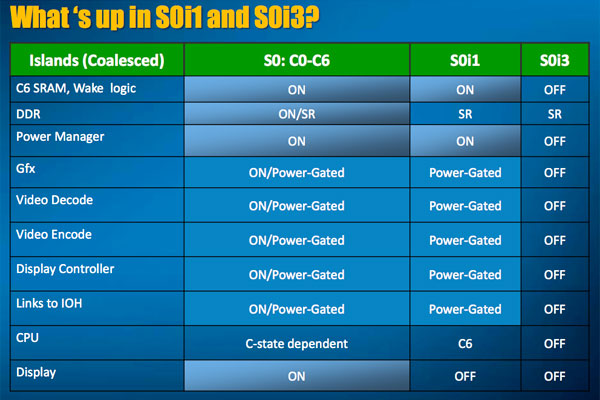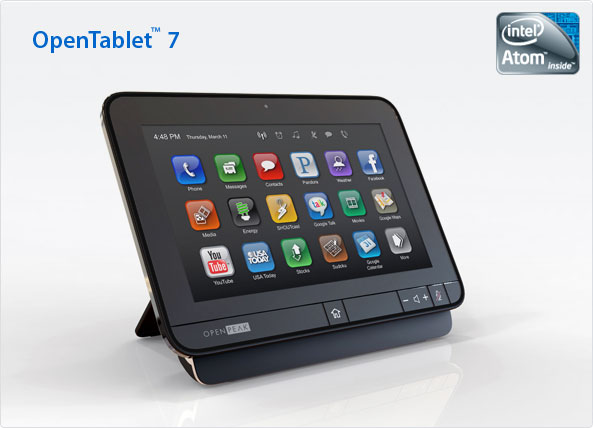New atomic platform
On May 4, Intel officially unveiled its new platform (formerly known as Moorestown ) based on the Intel Atom processor to the public - finally some details became known.

Honestly, I am pleasantly surprised - I advise you to print the highest quality popcorn)
It was possible to spend time on the painful inventing of an interesting introduction, but this time I decided to share only the “thick” one.
')
So, the new platform combines three components at once - the new Intel Atom Z6xx processor (previously known as Lincroft), the PCH MP20 I / O controller (Langwell) and the MSIC (Mixed Signal IC) chip, which is responsible for managing power consumption and battery charge.
First of all, in passing, a couple of words about technology
It combines the computational core (140 million transistors, 45-nm process technology; L2 cache size is 512Kb), a memory controller, and a video core with support for 3D graphics and video decoding. All this is integrated into the “system-on-chip” (System-on-Chip, SoC) - the experience of previous processor models showed that such a bundle can improve the efficiency of the system as a whole, and due to the increased degree of integration of elements, reduce the total power consumption and cost.
Clock speeds have grown up - for devices like PDAs and smartphones, 1.5 GHz have become the “bar”, while for older brothers the standard maximum is 1.9 GHz. The novelty has dimensions of 13.8x13.8x1.1 mm - such a “little one” practically does not limit in any way (in terms of mobility) the possibilities of constructing new devices - agree that it is great to have the functionality of a personalka (running ahead) on the device with the dimensions of the phone.

The integrated graphics core (now called Intel Intel GMA 600 ) operates at a clock frequency of 400 MHz, supports OpenGL ES 2.0, OpenGL 2.1 and OpenVG 1.1, hardware decoding of HD video (MPEG4 part 2, H.264, WMV, VC1) and its coding (MPEG4 part2, H.264). Video filming with a resolution of 1280x720 and video playback with a resolution of 1920x1080 (Full HD) became possible - did it wait, gentlemen?
System-on-Chip has two new power modes ( S0i1 and S0i3 ), which became a logical continuation of the C6 mode already available in the Intel Atom processor. They allow you to achieve consumption, measured in microwatts, and it is minimized not only in the mode of active use, but also in the standby mode. Especially for this, Intel has introduced a new power management mechanism at the operating system level, which is responsible for the power consumption of all system components, depending on the mode of operation.



A few words about new technologies. Intel Burst Performance (Intel BPT) allows, within a thermal package, to automatically increase the processor frequency for short intervals due to a request from the software. And Intel Smart Idle (Intel SIT), on the contrary, turns off the processor core and 19 system elements when the operating system remains in ON (S0) mode.
Contains I / O controllers, NAND memory, audio core, high-resolution camera controllers and USB, security blocks and a wireless adapter (a whole bunch of options are possible, including Bluetooth, 3G / HSPA, Wi-Fi (a / b / g / n ), WiMAX and, it seems, GPS).
Intel Smart Power (Intel SPT) technology allows you to manage power consumption at the software level, depending on the usage mode (both in work and in standby mode) —significant energy savings are achieved by dynamically turning off the power and network branches of the clock signal distribution.
Intel Smart & Secure (Intel S & ST) is a kind of hardware and software security architecture for mobile devices. Allows, for example, to speed up encryption processes when using industry standards (AES, DES, 3DES, RSA, ECC, SHA-1/2, DRM).
The roots of Intel Smart Sound Technology (Intel SST) are growing from a 24-bit digital signal processor that handles audio processing (supports MP3, AAC-LC, HE-AAC v1 and v2, WMA9 and PCM) and speech recognition. Again, due to reduced power consumption, the maximum autonomous operation time of the devices is ensured.
USB and USB On-The-Go (OTG) - well, who does not know it) USB-interface for connecting all sorts of peripherals and data transfer. Devices with USB OTG support can combine the USB host function and the peripheral controller function on a single chip.
Allows you to minimize the number of individual parts of the platform. On its board contains a control unit for power supply and battery charge, as well as a number of analog and digital components (such as audio codec, touch screen controller, some kind of sensors).
Speaking of the newly reduced energy consumption, the new platform exceeded all expectations. In standby mode, it has become more than 50 times lower, in sound playback mode - more than 20 times, and in web browsing mode and video viewing mode - 2-3 times lower compared to the previous generation Intel platform (Menlow) ! Accordingly, such savings made it possible from one full battery charge (based on a capacity of only 1500 mAh) to operate the device for 10 days in standby mode, up to 2 days in music playback mode and up to 4-5 hours in web mode. surfing or watching videos! And, no less important, all this - with increased productivity. If we talk about "at times", the new platform offers 1.5-3 times higher speed when working with applications, 2-4 times higher when working with graphics, and more than 4 times higher with JavaScript.

Summarizing the above, the new development has all the chances to become one of the most powerful mobile platforms - at least the existing Snapdragon will have to make room. Moreover, the release of Intel-architecture on the smartphone market can be fully considered a debut. Thanks to the support of many operating systems (including Android, Meego 1.0 and Moblin 2.1) and the fact that the platform is, in principle, already available for sale, in the very near future we should expect the appearance of new devices (and a couple of them have already been presented at exhibitions) while very interesting and functional. And this, you know, a balm for the soul)

I take this opportunity to recall that the competition for applications for mobile devices based on the Intel Atom processor is in full swing. One of the habrayusers has already won their $ 10k - anyone who tries can take the remaining prizes.
So, look forward to.

Honestly, I am pleasantly surprised - I advise you to print the highest quality popcorn)
It was possible to spend time on the painful inventing of an interesting introduction, but this time I decided to share only the “thick” one.
')
So, the new platform combines three components at once - the new Intel Atom Z6xx processor (previously known as Lincroft), the PCH MP20 I / O controller (Langwell) and the MSIC (Mixed Signal IC) chip, which is responsible for managing power consumption and battery charge.
First of all, in passing, a couple of words about technology
Intel Atom Z6xx processor
It combines the computational core (140 million transistors, 45-nm process technology; L2 cache size is 512Kb), a memory controller, and a video core with support for 3D graphics and video decoding. All this is integrated into the “system-on-chip” (System-on-Chip, SoC) - the experience of previous processor models showed that such a bundle can improve the efficiency of the system as a whole, and due to the increased degree of integration of elements, reduce the total power consumption and cost.
Clock speeds have grown up - for devices like PDAs and smartphones, 1.5 GHz have become the “bar”, while for older brothers the standard maximum is 1.9 GHz. The novelty has dimensions of 13.8x13.8x1.1 mm - such a “little one” practically does not limit in any way (in terms of mobility) the possibilities of constructing new devices - agree that it is great to have the functionality of a personalka (running ahead) on the device with the dimensions of the phone.

The integrated graphics core (now called Intel Intel GMA 600 ) operates at a clock frequency of 400 MHz, supports OpenGL ES 2.0, OpenGL 2.1 and OpenVG 1.1, hardware decoding of HD video (MPEG4 part 2, H.264, WMV, VC1) and its coding (MPEG4 part2, H.264). Video filming with a resolution of 1280x720 and video playback with a resolution of 1920x1080 (Full HD) became possible - did it wait, gentlemen?
System-on-Chip has two new power modes ( S0i1 and S0i3 ), which became a logical continuation of the C6 mode already available in the Intel Atom processor. They allow you to achieve consumption, measured in microwatts, and it is minimized not only in the mode of active use, but also in the standby mode. Especially for this, Intel has introduced a new power management mechanism at the operating system level, which is responsible for the power consumption of all system components, depending on the mode of operation.



A few words about new technologies. Intel Burst Performance (Intel BPT) allows, within a thermal package, to automatically increase the processor frequency for short intervals due to a request from the software. And Intel Smart Idle (Intel SIT), on the contrary, turns off the processor core and 19 system elements when the operating system remains in ON (S0) mode.
Intel PCH (Platform Controller Hub) M20 Controller
Contains I / O controllers, NAND memory, audio core, high-resolution camera controllers and USB, security blocks and a wireless adapter (a whole bunch of options are possible, including Bluetooth, 3G / HSPA, Wi-Fi (a / b / g / n ), WiMAX and, it seems, GPS).
Intel Smart Power (Intel SPT) technology allows you to manage power consumption at the software level, depending on the usage mode (both in work and in standby mode) —significant energy savings are achieved by dynamically turning off the power and network branches of the clock signal distribution.
Intel Smart & Secure (Intel S & ST) is a kind of hardware and software security architecture for mobile devices. Allows, for example, to speed up encryption processes when using industry standards (AES, DES, 3DES, RSA, ECC, SHA-1/2, DRM).
The roots of Intel Smart Sound Technology (Intel SST) are growing from a 24-bit digital signal processor that handles audio processing (supports MP3, AAC-LC, HE-AAC v1 and v2, WMA9 and PCM) and speech recognition. Again, due to reduced power consumption, the maximum autonomous operation time of the devices is ensured.
USB and USB On-The-Go (OTG) - well, who does not know it) USB-interface for connecting all sorts of peripherals and data transfer. Devices with USB OTG support can combine the USB host function and the peripheral controller function on a single chip.
MSIC Chip (Mixed Signal IC, Briertown)
Allows you to minimize the number of individual parts of the platform. On its board contains a control unit for power supply and battery charge, as well as a number of analog and digital components (such as audio codec, touch screen controller, some kind of sensors).
Speaking of the newly reduced energy consumption, the new platform exceeded all expectations. In standby mode, it has become more than 50 times lower, in sound playback mode - more than 20 times, and in web browsing mode and video viewing mode - 2-3 times lower compared to the previous generation Intel platform (Menlow) ! Accordingly, such savings made it possible from one full battery charge (based on a capacity of only 1500 mAh) to operate the device for 10 days in standby mode, up to 2 days in music playback mode and up to 4-5 hours in web mode. surfing or watching videos! And, no less important, all this - with increased productivity. If we talk about "at times", the new platform offers 1.5-3 times higher speed when working with applications, 2-4 times higher when working with graphics, and more than 4 times higher with JavaScript.

Summarizing the above, the new development has all the chances to become one of the most powerful mobile platforms - at least the existing Snapdragon will have to make room. Moreover, the release of Intel-architecture on the smartphone market can be fully considered a debut. Thanks to the support of many operating systems (including Android, Meego 1.0 and Moblin 2.1) and the fact that the platform is, in principle, already available for sale, in the very near future we should expect the appearance of new devices (and a couple of them have already been presented at exhibitions) while very interesting and functional. And this, you know, a balm for the soul)

I take this opportunity to recall that the competition for applications for mobile devices based on the Intel Atom processor is in full swing. One of the habrayusers has already won their $ 10k - anyone who tries can take the remaining prizes.
So, look forward to.
Source: https://habr.com/ru/post/92909/
All Articles